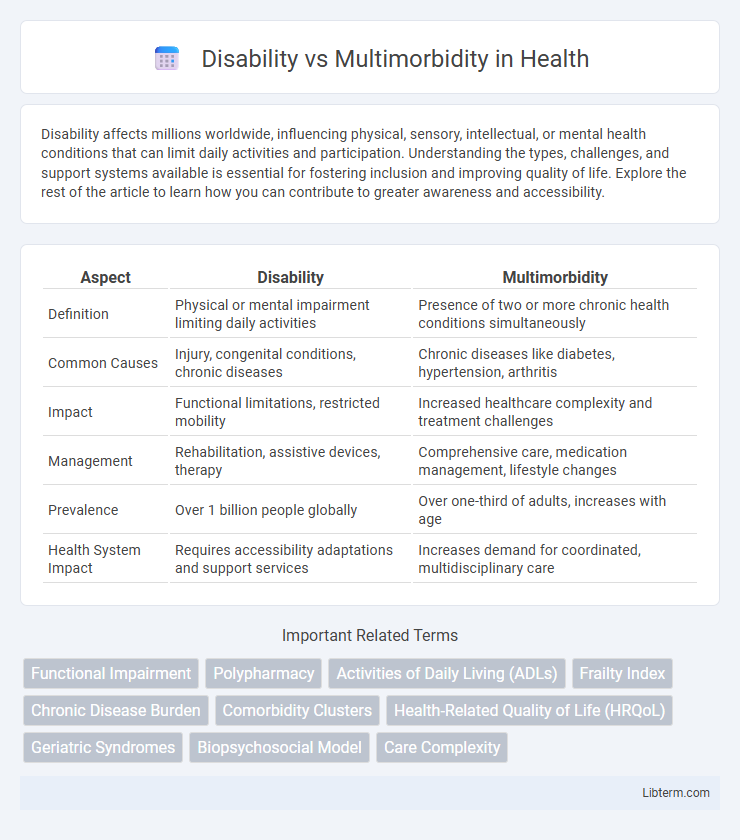Disability affects millions worldwide, influencing physical, sensory, intellectual, or mental health conditions that can limit daily activities and participation. Understanding the types, challenges, and support systems available is essential for fostering inclusion and improving quality of life. Explore the rest of the article to learn how you can contribute to greater awareness and accessibility.
Table of Comparison
| Aspect | Disability | Multimorbidity |
|---|---|---|
| Definition | Physical or mental impairment limiting daily activities | Presence of two or more chronic health conditions simultaneously |
| Common Causes | Injury, congenital conditions, chronic diseases | Chronic diseases like diabetes, hypertension, arthritis |
| Impact | Functional limitations, restricted mobility | Increased healthcare complexity and treatment challenges |
| Management | Rehabilitation, assistive devices, therapy | Comprehensive care, medication management, lifestyle changes |
| Prevalence | Over 1 billion people globally | Over one-third of adults, increases with age |
| Health System Impact | Requires accessibility adaptations and support services | Increases demand for coordinated, multidisciplinary care |
Understanding Disability: Definitions and Context
Disability refers to impairments, activity limitations, and participation restrictions resulting from physical, mental, or sensory conditions that affect an individual's ability to engage in daily life. It is a complex, multidimensional concept shaped by social, environmental, and personal factors rather than solely by medical diagnoses. Understanding disability requires distinguishing it from multimorbidity, which involves the coexistence of multiple chronic diseases without necessarily causing functional limitations or social barriers.
What is Multimorbidity? Key Concepts
Multimorbidity refers to the coexistence of two or more chronic medical conditions within an individual, impacting overall health outcomes and complicating clinical management. This concept highlights the interplay between different diseases, requiring integrated care approaches to address overlapping symptoms and treatment regimens. Understanding multimorbidity is crucial for developing personalized healthcare plans that improve quality of life and reduce disability risks in affected patients.
Prevalence and Demographics: Disability vs Multimorbidity
Disability affects approximately 15% of the global population, with higher prevalence among older adults and females, while multimorbidity, defined as the coexistence of two or more chronic conditions, affects over 40% of adults aged 65 and older. Multimorbidity prevalence increases sharply with age, impacting socioeconomically disadvantaged groups disproportionately, and often leads to functional decline and disability. Both conditions exhibit strong associations with aging and socioeconomic status, highlighting the need for integrated healthcare strategies targeting these vulnerable populations.
Distinct Causes and Risk Factors
Disability often arises from specific impairments or injuries such as stroke, spinal cord injury, or congenital conditions, which directly limit physical or cognitive functions. Multimorbidity refers to the coexistence of two or more chronic diseases like diabetes, hypertension, and arthritis, driven by complex interrelated risk factors including age, lifestyle, genetic predisposition, and socioeconomic status. While disability primarily results from acute or chronic health events causing functional limitations, multimorbidity is shaped by cumulative health deterioration influenced by chronic disease interplay and systemic health risks.
Overlaps: When Disability and Multimorbidity Coexist
Disability and multimorbidity frequently overlap, with individuals often experiencing multiple chronic conditions that contribute to functional limitations and reduced quality of life. The coexistence of multimorbidity amplifies the complexity of managing disabilities due to interactions between diseases, increased healthcare needs, and greater risk of adverse health outcomes. Understanding this overlap is essential for designing integrated care models that address both the impairments caused by disabilities and the comprehensive management of multiple chronic illnesses.
Impact on Quality of Life and Daily Functioning
Disability often results in significant limitations in physical, sensory, or cognitive functions that directly impair mobility, self-care, and social participation, substantially reducing overall quality of life. Multimorbidity, characterized by the coexistence of multiple chronic conditions, exacerbates the complexity of managing health and daily routines, leading to increased symptom burden and psychological stress. Both disability and multimorbidity independently and synergistically diminish daily functioning, necessitating comprehensive care approaches to optimize well-being and maintain autonomy.
Healthcare Challenges and Systemic Barriers
Disability and multimorbidity present distinct healthcare challenges, with disability often requiring specialized assistive services and adaptive care environments, while multimorbidity demands integrated management of multiple chronic conditions, complicating treatment protocols. Systemic barriers such as fragmented care coordination, limited access to multidisciplinary teams, and insufficient reimbursement models exacerbate difficulties in delivering comprehensive care for both populations. Addressing these obstacles necessitates health system reforms emphasizing patient-centered approaches, enhanced provider training, and expanded access to accessible infrastructure and resources.
Diagnostic Approaches: Disability vs Multimorbidity
Diagnostic approaches for disability primarily involve functional assessments and standardized tools such as the WHO Disability Assessment Schedule (WHODAS), which evaluate impairments in physical, mental, or sensory functions. In contrast, multimorbidity diagnosis relies on comprehensive clinical evaluations and the identification of co-occurring chronic conditions through patient history, laboratory tests, and imaging studies. Precision in distinguishing between disability and multimorbidity is essential for tailored care plans, influencing treatment prioritization and resource allocation.
Management Strategies and Support Solutions
Effective management strategies for disability emphasize personalized rehabilitation programs, assistive technologies, and accessible environments to enhance independence and quality of life. Multimorbidity requires integrated care models, coordinated medication regimens, and continuous monitoring to address the complexity of coexisting chronic conditions. Support solutions combining multidisciplinary healthcare teams, patient education, and digital health tools optimize outcomes by addressing both physical limitations and multiple disease management simultaneously.
Policy Implications and Future Research Directions
Disability and multimorbidity intersect with significant implications for health policy, necessitating integrated care models that address both functional limitations and multiple chronic conditions. Policy frameworks should prioritize resource allocation for coordinated healthcare services, social support systems, and accessibility enhancements tailored to diverse patient needs. Future research must explore longitudinal outcomes, effective intervention strategies, and equity in care delivery to inform adaptive policies that reduce disparities and improve quality of life for affected populations.
Disability Infographic

 libterm.com
libterm.com